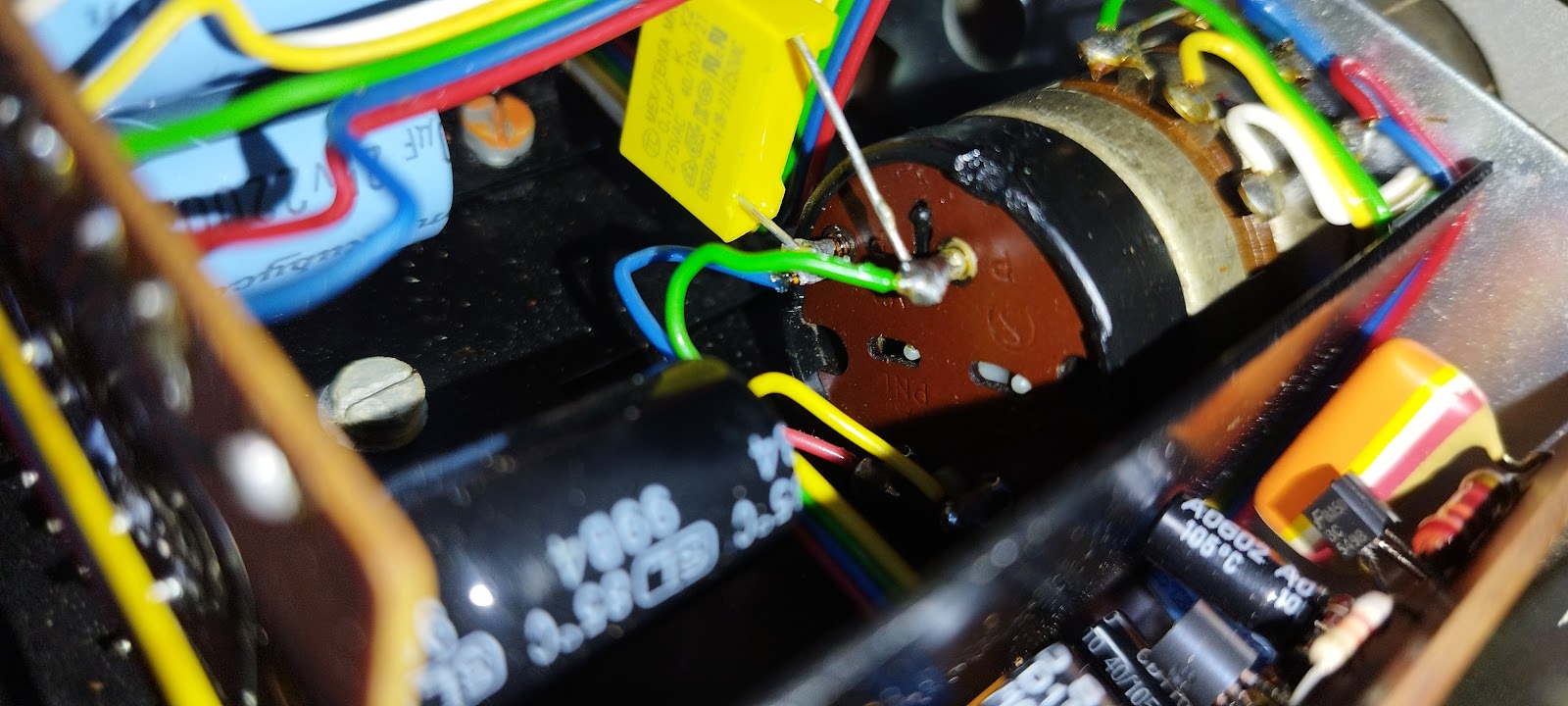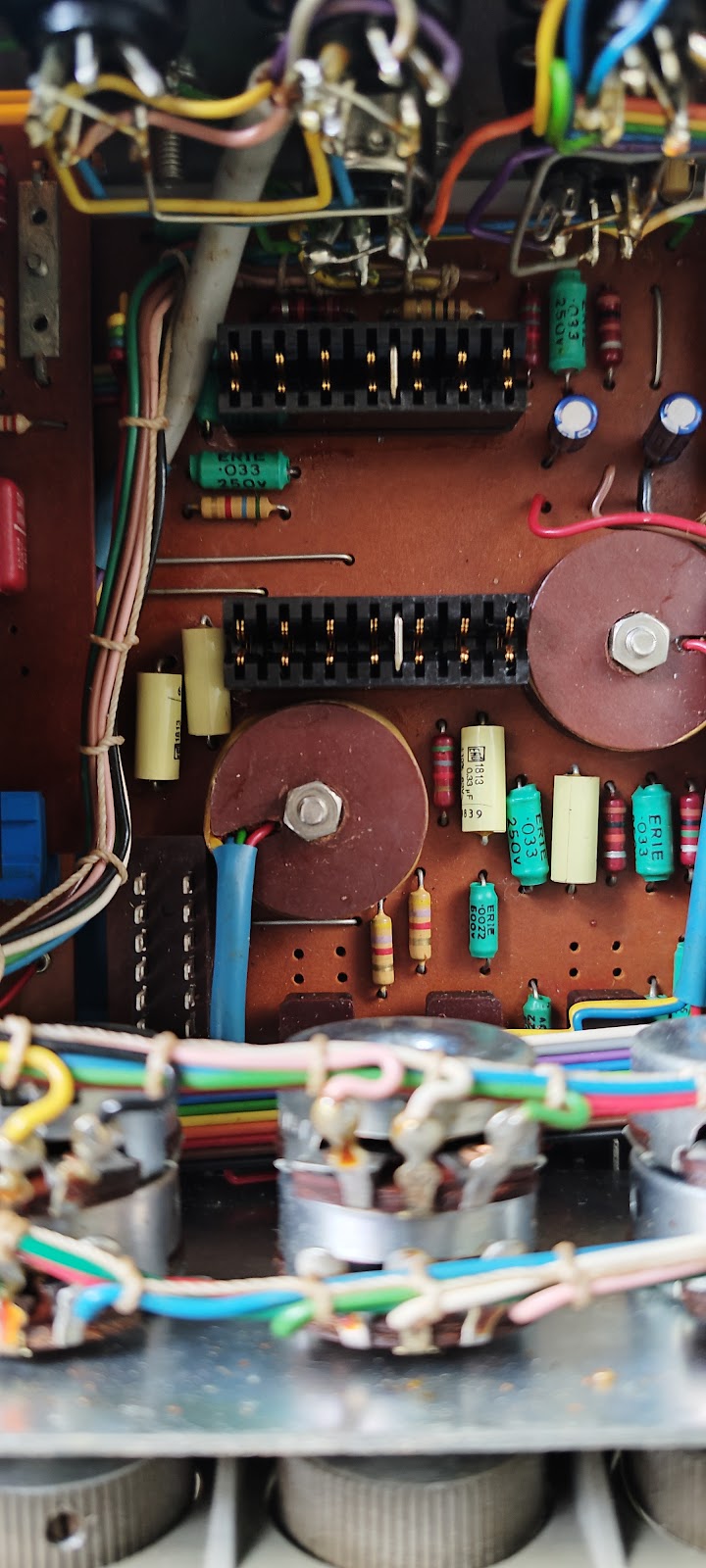After fixing the "broken" balance control on Quad 33 #2, I then discovered there were a few things not right on this Quad 33.
Most apparent issue was 😒only RHS had audio.
The rectification adventure was "interesting". Here's how it unfolded:-
- Powering-on the Quad 33 #2 now came with a "loud thud". Could see the suppressing RIFA on the volume control. However on closer inspection, I then saw the physical damage inside the insulating plastic. As I did not have a exact replacement (RIFA 0.047uF X2) on hand, I used a spare 0.1uF X2 275V ... does the job.
%20-%20Copy.jpg)
How to connect the suppressive capacitor Bad RIFA X2 Alternative X2 capacitor - Next was to perform the most basic test - swap the LHS with the RHS amplifier boards, no effect. "Borrowed" the amplifier boards from Quad 33 #1 (aka #1 from here thereafter), same result. Only RHS had audio.
- Proceeded to swap the other Quad 33 boards from #1, again no difference.
- This would imply an issue on either the motherboard PCB, the connections, and/or switches on the unit chassis.
- Visually checking the unit reveals no obvious issues.
- Searching the various online forums reveal many such issues, caused by various part failure(s) due to age of the components.
- Since I do not have an oscilloscope, I will have to use my Digital Multi Meter (aka DMM) and test for bad components one at a time (without removal from the PCB - yea, was lazy and hoping to strike gold!). They all passed😕
- Not satisfied I reference the Quad 33 schematics and started to unsolder capacitors from the motherboard for testing. The moment I unsoldered C3, the capacitor just drop out as one of it's leads dislocated from the main capacitor body. Since I did not have a spare 0.033uF axial capacitor, I substituted a similar spacing size 0.022uF to test if that is the source of the problem. 😒still no audio from LHS but did note this time I could hear a soft "pof" from the LHS during power-on. Rest of the LHS capacitors on the motherboard passed.
Broken 0.033uF capacitors which fell out upon desoldering - Stumped, I decided to try swapping the amplifier boards again. 😮There was now audio on the LHS but not RHS😕??? Hence I borrowed the amplifiers boards from #1 again - confirmed now there is audio on LHS but not RHS!
- Thus now repeating Step-7 for RHS circuit on the motherboard, to discover that C10 failed in the same way - capacitor lead broke away after de-soldering and fell from motherboard. Used another 0.022uF as temporary substitute and there was now audio from both channels when using the amplifier boards last deployed (from #1)😁

C3 and C10 on the Quad 33 motherboard schematic 
C3 & C10 high-lighted on the Quad 33 motherboard C3&4&9&10 replaced on the Quad 33 motherboard - Will replace C3&4 on the LHS and C9&10 on the RHS channels, to ensure "sonic matching" since there is a potentiometer in between these capacitors (on both channels).
- Next I returned #1 boards and reseat the original amplifier boards (from #2) back into the Quad 33 ... 😕again no sound from RHS??? However this time the audio moved when I swapped the LHS and RHS amplifier boards.
- Therefore, there is a bad component(s) on the original RHS amplifier board. Resumed testing components one-by-one using the DMM and transistor tester. Finally ... R406 was the bad component (270Kohm 1/4watt).
Bad R406 270Kohm resistor on amplifier board - Once R406 was replaced, both audio channels were audioable again. Had to adjust the balance slightly as the reproduction was just slightly off centered. Most likely cause is the use of different brands/make/wattage resistors on both amplifier boards - "re-alignment" task for another day...
Finally realised why Quad 33 #1 did not experience any issue of loss of audio on 1-channel - I had replaced all the axial capacitors on that motherboard long time ago as I wanted a unit to compare the reproduction difference when using original vs modern capacitors!!!
















































